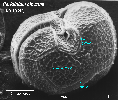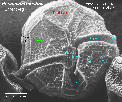Peridinium
Ultrastructure
 Scanning
electron microscopy of Peridiniumspecies reveals features of plate
structure not visible with the light microscope, in particular delicate
ornamentation patterns on the plates.
It can also
reveal small plates in the vicinity of the flagellar bases that would not
otherwise be observed. Scanning
electron microscopy of Peridiniumspecies reveals features of plate
structure not visible with the light microscope, in particular delicate
ornamentation patterns on the plates.
It can also
reveal small plates in the vicinity of the flagellar bases that would not
otherwise be observed. |
 Plate number,
arrangement and ornamentation (including the features of cryptic plates in
the flagellar groove can be of taxonomic value. Plate number,
arrangement and ornamentation (including the features of cryptic plates in
the flagellar groove can be of taxonomic value. |
Peridiniumcells, like most dinoflagellates, have a nucleus
with permanently-condensed
chromosomes that lack histones. Mitochondria have tubular cristae. The
cytoskeleton is based
on an asymmetrical array of two major microtubular roots arising from two
flagellar bases. As
in other dinoflagellates, a major membranous organelle, the pusule, is
found in the vicinity of the
flagellar bases. Plastids have thylakoid membranes in groups of three.
Pyrenoids may or may not be present.
Return to summary information
 Scanning
electron microscopy of Peridiniumspecies reveals features of plate
structure not visible with the light microscope, in particular delicate
ornamentation patterns on the plates.
It can also
reveal small plates in the vicinity of the flagellar bases that would not
otherwise be observed.
Scanning
electron microscopy of Peridiniumspecies reveals features of plate
structure not visible with the light microscope, in particular delicate
ornamentation patterns on the plates.
It can also
reveal small plates in the vicinity of the flagellar bases that would not
otherwise be observed.